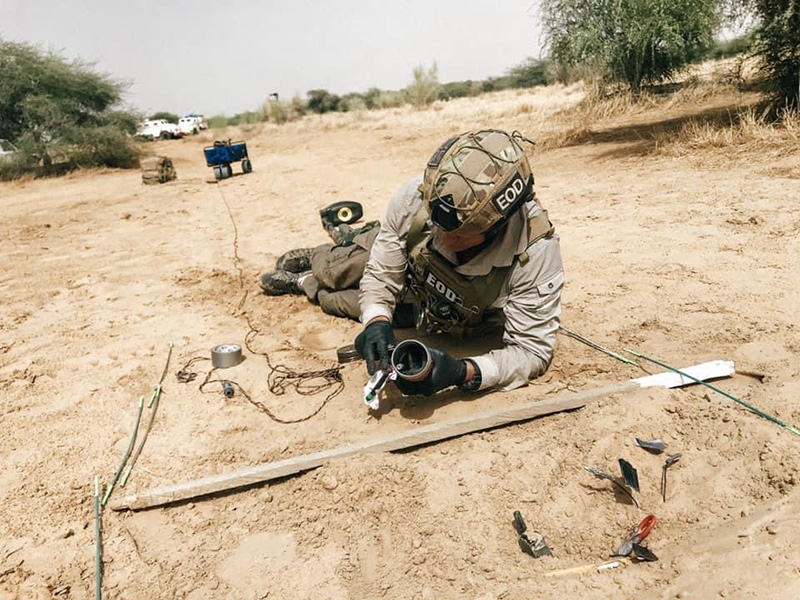Assault IEDD Course
Assault IEDD is the intrinsic improvised explosive device disposal (IEDD) support to Special Operations Forces (SOF) and Special Weapons & Tactics (SWAT) Police Units who are conducting an assault on a building or vessel occupied by terrorists.
It is the rendering safe of suspected or confirmed IED threats within a tactical environment which also includes IEDs attached to hostages.
SafeLane Assault IEDD Operator course is an advanced qualification for already qualified Advanced IEDD Operators.
ECM (Electronic Countermeasure) Operator Course
SafeLane electronic countermeasure (ECM) operator course qualifies a student to provide an IEDD team with the knowledge to operate ECM capability consisting of vehicle borne and man portable systems (as required by the intended capability scale). Students will develop an understanding of ECM tactics and systems.
The course will be designed to the specific needs of the defence or law enforcement organisation.
C-IED Staff Officer Training Course
SafeLane C-IED Staff Officer course qualifies C-IED commanders in the understanding and application of NATO’s ‘C-IED Areas of Activity’. This ensures C-IED commanders will have a critical integrated approach to focus the national CIED effort effectively and coordinate C-IED activities at all levels.
This course qualifies C-IED Staff Officers to effectively operate in multi-national C-IED command centre as and establish an operational C-IED framework.
High Risk Search Course
SafeLane High Risk Search course teaches students the capability to locate specific explosive targets using intelligence assessments, systematic procedures, and appropriate detection techniques. High Risk Search operators are usually employed in semi and non-permissive environments as an integral part of IEDD task conduct to ensure the safety of the public, cordon and IEDD team.
Basic Field Exploitation (Level 1) Course
Basic Field Exploitation (BFE) Level 1 is a vital component of Attack the Network (AtN) activity. Students are trained to gather Information to provide a picture of adversary capabilities and intentions, perpetrator relationships and the technical construction of a device.
BFE Level 1 teaches students the tactical-level recording and recovery of material and information. BFE level 1 is usually employed at incidents such as IED task or post-blast investigations. BFE operators have the challenging task of trying to gather as much information as possible, often under considerable time pressures due to hostile or dangerous environments.
Medical Training
SafeLane Global designs and delivers medical and first aid training adapted to hostile and war zone environments where equipment and personnel are limited.
The hands-on training programmes explain, demonstrate and reinforce the differences between battlefield first aid and civilian pre-hospital trauma care, and arm participants with critical skills and confidence to deal with complex medical emergencies in high stress environments.
Most scenarios involving victims of medical trauma caused by explosive remnants of war (ERW) or improvised explosive devices (IEDs) – whether in a live or post-conflict environment – require those on scene to make immediate tactical and critical medical decisions.
These have to be made under intense stress and potentially imminent danger.
Without comprehensive, dedicated, and appropriate training anyone in this situation will be risking the health – possibly life – of both the victim and their entire team.
SafeLane Global’s own field personnel face these situations fully trained, as do its medical training course participants.
The relevant and unrivalled training programmes SafeLane Global designs and delivers are not only based on the real world experience of its highly skilled educators, but based on up to date scenarios and the latest medical skills and techniques.
Attendees graduate courses equipped with the knowledge, skills, techniques – and critically, the self-confidence needed to take the correct action in a timely and calm manner to prevent battlefield deaths.
Training is bespoke to each client’s needs, but is based on four core objectives: –
- Tactical combat casualty care (TCCC),
- Treatment of patients,
- Prevention of further casualties, and
- Completion of the mission.
Battlefield Emergency First Aid (BEFA) and First Aid Refresher Courses
Battlefield emergency first aid (BEFA) training is valuable for all arms of service deployed on operations. It teaches basic trauma care skills for use during deployment. Besides basic first aid, it also covers the contents of the individual first aid kit (IFAK) and its use, blast injuries and environmental injuries. Refresher courses are also offered
Combat Trauma Care (CTC) Course
Combat trauma care training provides troops with the knowledge, skills and ability to act as a first responder to the scene of a casualty. The aim of the course is to teach the student how to evaluate a situation where a casualty needs urgent medical attention, how to stop bleeding, treat blast injuries, achieve spinal immobilisation and transport patients.


